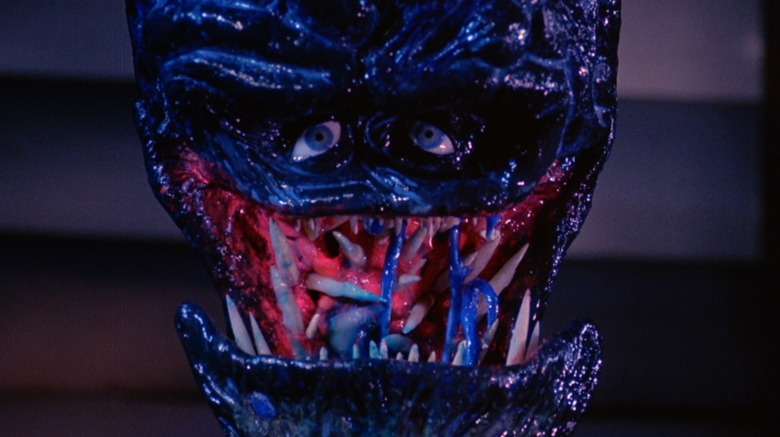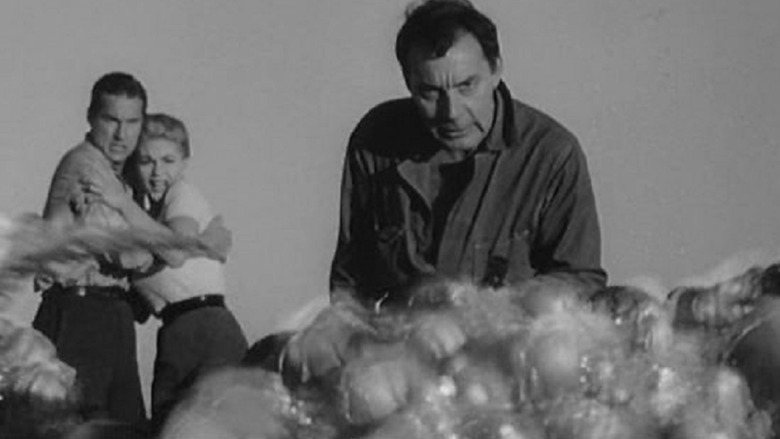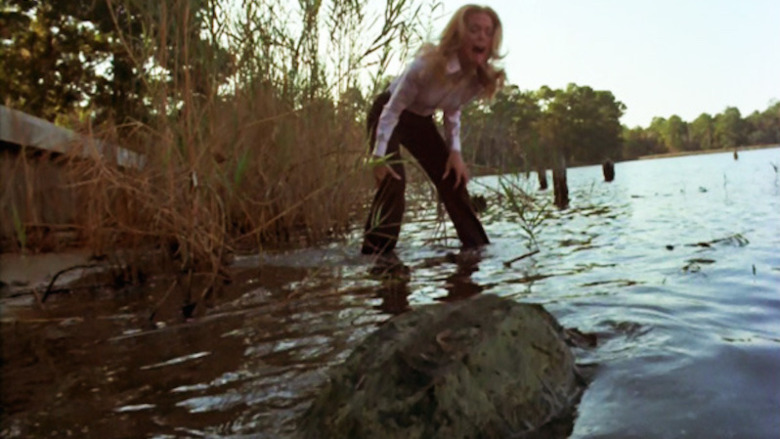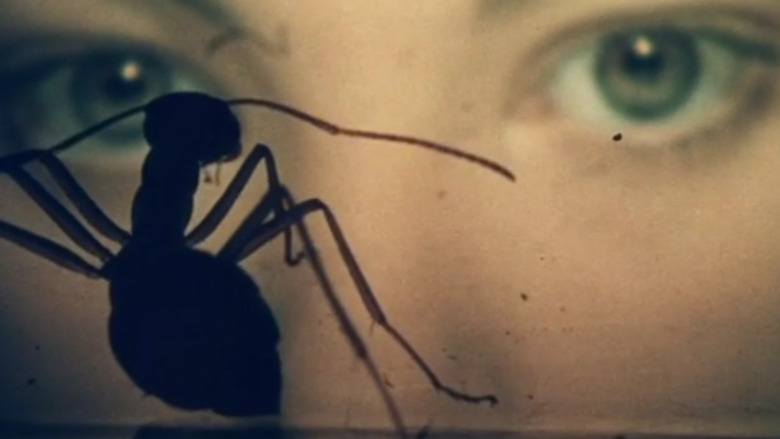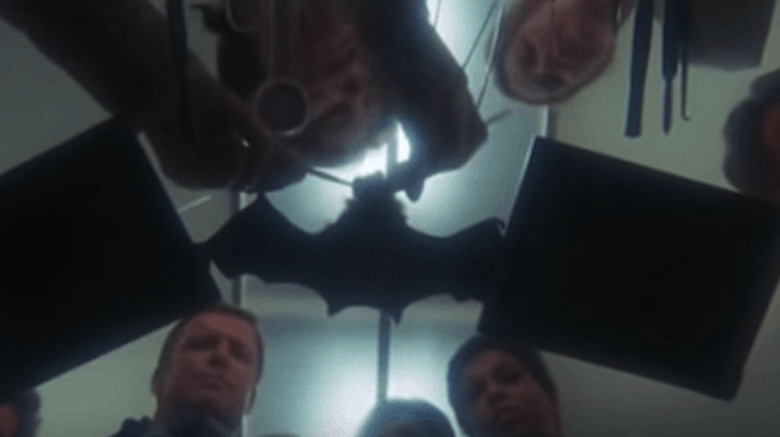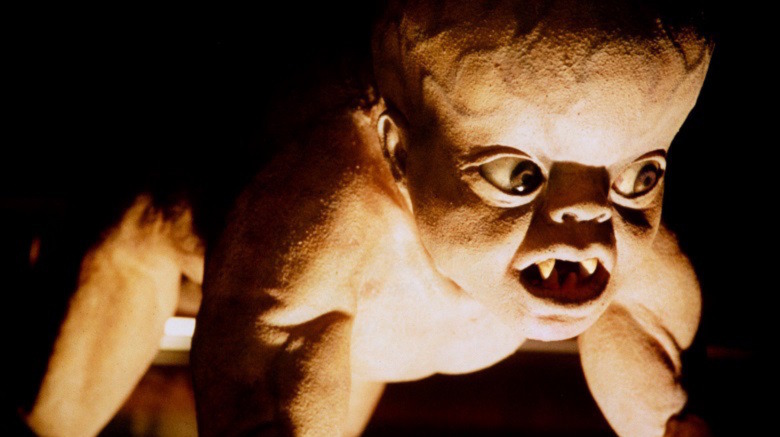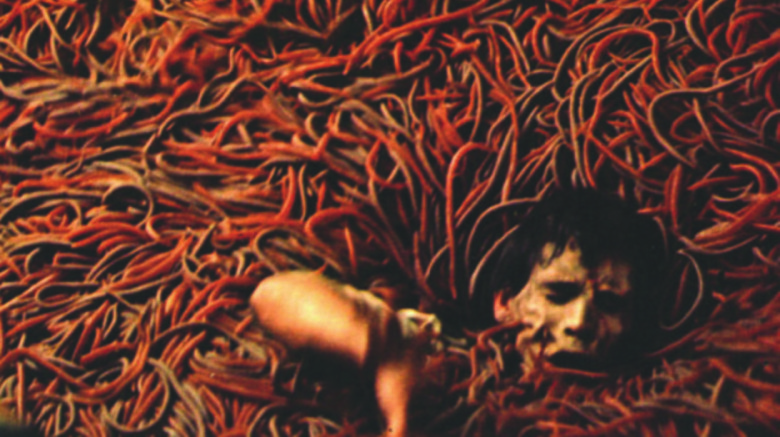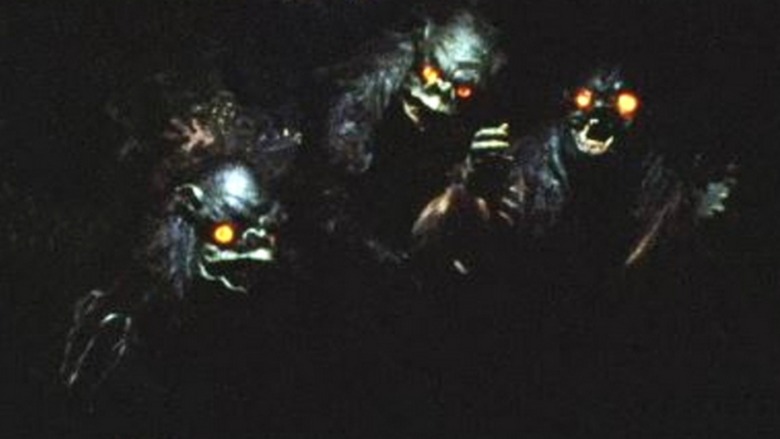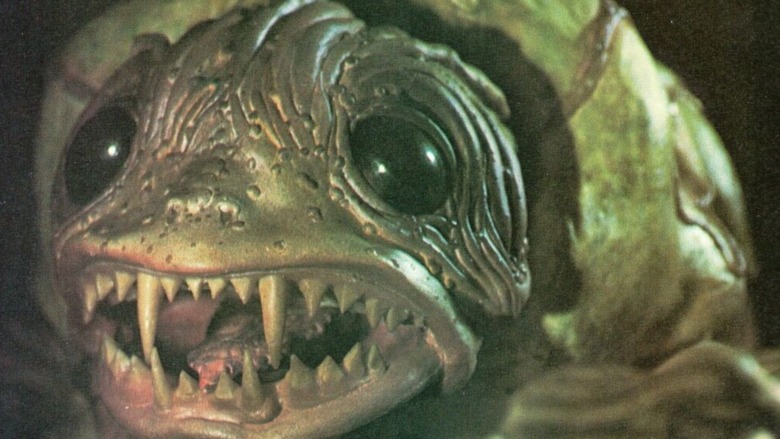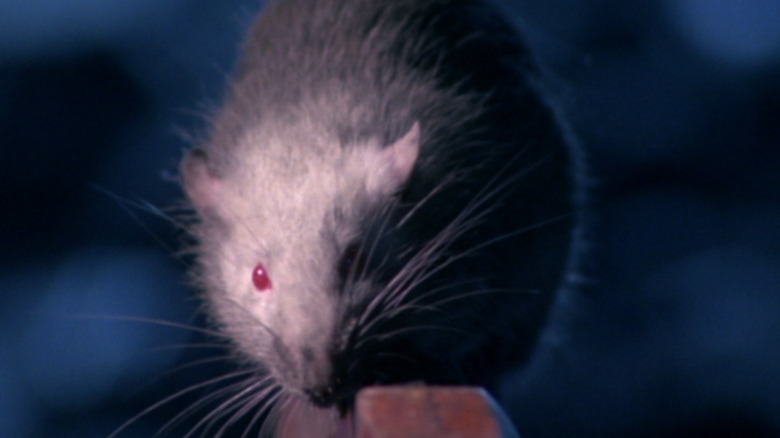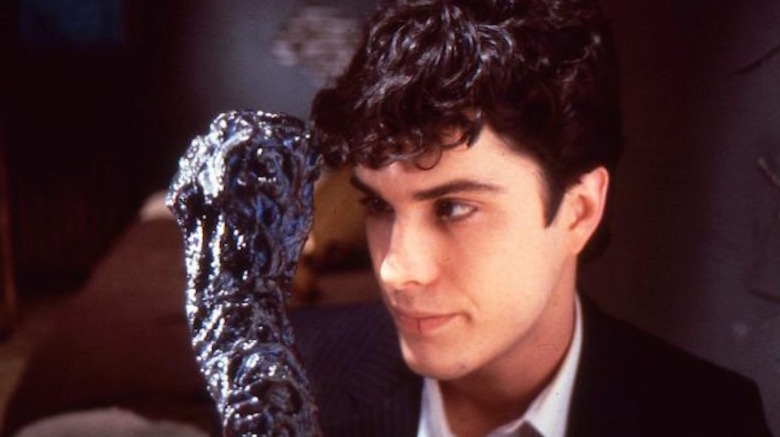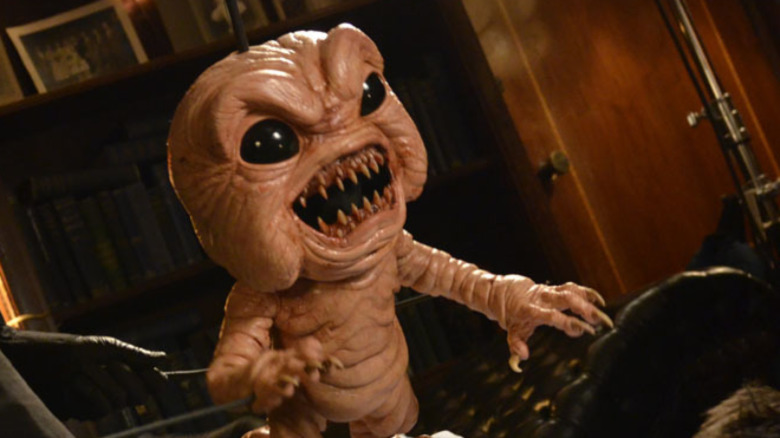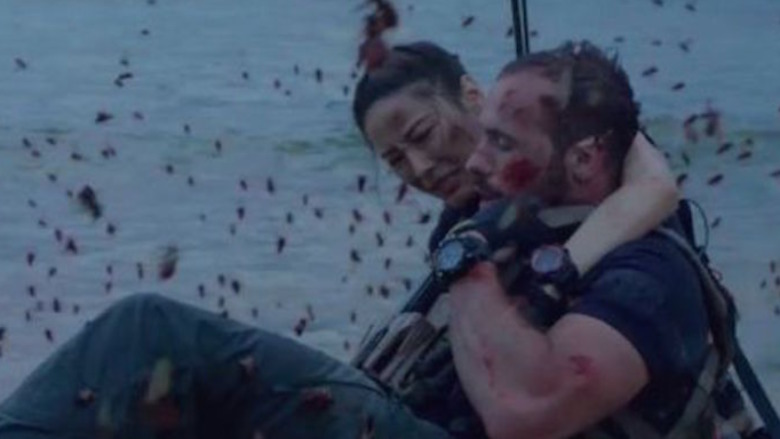Tiny, Terrifying Monsters In Horror And Sci-Fi You've Never Heard Of
We may receive a commission on purchases made from links.
While there's plenty of attention and press devoted to both giant movie monsters and human-sized ones — like Dracula and Frankenstein — it sometimes feels like the littlest creatures get the least amount of attention. It's unfortunate, because many of these bite-sized beasts are just as terrifying as their bigger relatives. Joe Dante's "Gremlins" is not only a perfect example, but also produced countless imitation pint-sized creatures, some good ("Critters," "Ghoulies"), some not ("Hobgoblins"). Made-for-TV terrors from the 1970s gave us the tiny, whispering trolls in 1973's "Don't Be Afraid of the Dark" and the relentless Zuni fetish doll in "Trilogy of Terror" from 1975, while mainstream features offer a horde of little menaces, from the invasive Hammerpede in "Prometheus" to the man-eating Tooth Fairies in "Hellboy II: The Golden Army."
These are some of the better-known examples, but a deep dive into the horror and sci-fi movie ranks will yield many more mini-monstrosities. Following is a list of little movie terrors from the past half-century, many of which may be making your acquaintance for the first time due to the relative obscurity of their origins. Don't be fooled by their appearance: as these monsters prove, tiny doesn't always translate as cute and cuddly.
And spoilers will follow.
The Flesh Eaters and their comic book connections
The title creatures from 1964's "The Flesh Eaters" are the tiniest of movie terrors on this list, but also the most dangerous. Water-dwelling microbes that devour any living organism down to the bones, the Flesh Eaters are the diabolical result of Nazi experimentation that, as the survivors of a plane crash discover, has continued unchecked on a remote island occupied by certifiable mad scientist Martin Kosleck.
The sole directorial effort of actor Jack Curtis – who provided voices for many '60s-era cartoons like "Speed Racer" — "The Flesh Eaters" offers pulpy low-budget thrills and endearingly crude visual effects. The giant microbe that appears at the end of the film was created by Curtis's cousin, stage magician Roy Benson, with fabric treated with chemicals. However, the most memorable element is the still-shocking gore, most notably in a sequence when castaway beatnik Omar (Ray Tudor) drinks a glass of water filled with the microbes, which proceed to messily devour him from the inside.
These grisly sequences, as well as the film's all-caps dialogue ("THERE'S SOMETHING IN THIS WATER THAT EATS FLESH!") and some optical effects, are the work of Arnold Drake. A legendary figure in comic book history, Drake's credits include co-creation of the "Doom Patrol" (including Beast Boy) and "Deadman" for DC, and with Gene Colan and Stan Lee, the original iteration of the "Guardians of the Galaxy" for Marvel in 1969.
The swamp fights back in Frogs
One of the most offbeat films in the "nature runs amok" cycle of the early 1970s that followed in the wake of "Willard," "Frogs" folds the critter-attack formula into a "Ten Little Indians" scenario, with the flora and fauna of the Florida Everglades doing away with the members of a tart-tongued Southern family. A mustache-free Sam Elliott is a nature photographer chronicling the toll of pollution on the swamps; the culprit is cranky Southern patrician Ray Milland, whose celebration of his birthday and the Fourth of July with his venomous family is interrupted by Elliott and later, everything creepy and crawly around their mansion.
The cast, which includes future TV star Joan Van Ark, appears to enjoy playing variations on Rich White Privilege (with model/party guest Judy Pace offering Black perspective), but their primary role is victim to various swamp reptiles and insects. Actors do their best to look frightened while pretending to die by tarantula bite, turtle attack, snake assault, and what appears to be sentient creeping moss. Despite their prominence in the title, frogs only claim one major kill, but it's Milland, who comes to regret his anti-ecology stance when he's overrun by a tidal wave of toads.
Psychedelic ants attack in Phase IV
The brilliant, Oscar-winning graphic designer Saul Bass, who created iconic, influential title sequences and one-sheets for such films as "Psycho," "Seconds," and "Casino," made his sole effort as feature director with the cerebral and, at times, psychedelic 1974 science fiction thriller "Phase IV," about a revolt against humanity by ants. Though the premise suggests a sort of man-vs.-insect shocker, Bass takes a cooler approach to their world takeover, which begins with the ants' construction of complex geometric structures and designs in the Arizona desert.
Scientists Nigel Davenport and Michael Murphy attempt to determine the ants' plan, but are met with orchestrated attacks that resist insecticide, wipe out their lab and computers, and eventually place them in harm's way. The scenes of the ants' assault on the scientists' domed based are made unnerving by extreme close-ups of the creatures by cinematographer Ken Middleham and an eerie electronic score by composer Brian Gascoigne. The human-ant conflict doesn't end with a climactic fight: Murphy soon discovers that the ants have something different in store for him and fellow survivor Lynne Frederick – something that will change the face of life on Earth.
Bass intended to close the film with an extended sequence depicting humanity's future: experimentation, adaptation, and finally, evolution into a new form of life integrated with the growing hive-mind of the ants. The baffling yet striking montage of strange imagery was cut by the film's distributor, Paramount Pictures, prior to release. However, the footage was discovered in 2012, and can be viewed through various online sources.
Chosen Survivors face bats and nuclear war
Bats have been staples of horror movies for decades, most notably in any number of vampire films. But their participation in these films is largely relegated to atmosphere; when directors have tried to move bats to main bad guy position, like in 1979's "Nightwing" or 1999's "Bats," the results have been underwhelming.
"Chosen Survivors," a little-seen 1974 hybrid of disaster movie, science fiction and horror, folds bats into an already unusual scenario: 11 people have been chosen by computer to shelter at an underground fallout shelter after being told that nuclear war has decimated the surface world. That horror is quickly compounded when the group discovers that hordes of vampire bats have invaded their shelter. What follows is a series of standoffs between humans and bats, as well as a out-of-left-field plot twist involving the truth behind the shelter.
Director Sutton Roley -– a veteran of episodic TV — ably handles the unusual premise and a cast of capable actors, including Oscar nominees Richard Jaeckel and Jackie Cooper, who would play Perry White five years later in the '79 "Superman." He also has considerable (and creepy) footage of real bats, which compensates for scenes in which subpar optical effects are used to depict their attacks.
It's Alive: the mutant baby movie with a social conscience
Can a movie about a rampaging mutant baby also be a sharp commentary on social and political issues? "It's Alive," cult auteur Larry Cohen's fourth feature as writer and director, proved it was possible. The 1974 film delivered a remarkably gruesome story: a middle-class couple's second child is born not only with terrible deformities but also a tremendous urge to kill.
Within that context, Cohen manages to address corporate malfeasance by companies that issue dangerous, untested drugs. Here, it's the pharmaceutical manufacturer that produced the fertility medication taken by the child's mother (played by Sharon Farrell), and which works overtime to cover its tracks. The medical community as a whole takes a beating in It's Alive, including the medical researchers that ask the child's father (John P. Ryan) to sign over his son's body to them after its death, and the craven doctor who agrees to relieve the pharma company from any liability.
The baby itself was created by Oscar-winning makeup effects designer Rick Baker, who doesn't receive a credit in the film. While the execution is typically impressive, even for a low-budget film, Cohen wisely keeps the creature off-screen or glimpsed only in partial light. He repeated that approach for the 1976 sequel, "It Lives Again," which features three mutant infants, but put the creatures — now fully grown — front and center in the next sequel, "It's Alive III: Island of the Alive," which lessened their impact.
Squirm makes worms even creepier
The challenge faced by the makers of 1976's "Squirm"? Transforming worms into terrifying movie monsters. The solution: lots and lots of worms, which descend on a small Southern town after electricity from a downed power line turns them homicidal. Writer-director Jeff Lieberman — whose credits include the unnerving cult thrillers Blue Sunshine and Satan's Little Helper – got the idea from a childhood incident in which his brother ran electricity from a toy train transformer into the ground to bring up worms for a fishing trip.
Lieberman finds a number of novel ways for worms to dispatch humans, the most gruesome of which is a sequence in which the film's heel, R.A. Dow, is attacked by sandworms that burrow into his face. Rick Baker's prosthetic effects design is shocking, but even that moment can't quite compare to the finale, in which thousands of worms appear to descend upon and engulf the town and its inhabitants.
To achieve a memorable set piece in which an entire room is filled with worms, Lieberman and his crew built a scaffolding over the floor and then filled it with canvas. Lieberman told Fangoria that after pouring thousands of worms onto the false floor, he invited a local Cub Scout troop to hunker under the canvas and "make the whole sea of worms undulate." The effect is as creepy as that sounds.
The kid hero of The Pit is worse than the monsters
There are two kinds of small monsters in the eccentric, Canadian-made, Wisconsin-lensed monster movie "The Pit," but only one of them lives in the titular hole. Those small, hairy, and ceaselessly hungry creatures, referred to as troglodytes, become a means to an end for 12-year-old Jamie (child actor Sammy Snyders) to dispatch anyone who gives him a hard time.
Based on that, it would seem that "The Pit" is a mix of "Carrie" and "The Crate," the episode involving the carnivorous monster-in-a-box in 1982's "Creepshow." But Jamie is unquestionably one of the weirdest and most unpleasant juvenile characters in any horror film — a spiteful little creep with a penchant for spying on his babysitter and engaging in long, unsettling conversations with his teddy bear (also voiced by Snyders) — so his "revenge" is really just an extended sick joke about a mean-spirited kid dispatching the mean-spirited people around him for being, well, mean-spirited.
Director Lew Lehrman offers only occasional glimpses of the creatures, which appear to be child-sized, hairy humanoids with glowing eyes and sharp teeth. They're exactly what you, as a kid, may have imagined as the source of noises under your bed or in your closet, and as such, give an extra layer of unpleasantness to a truly odd horror effort.
The Boogens are nothing to sneeze at
A positive review by Stephen King in the pages of Twilight Zone magazine briefly gave the low-budgeted and, until recently, little-seen creature feature "The Boogens" a spotlight back in 1981. Shot entirely in a pre-Sundance Park City, Utah, "The Boogens" concerns the re-opening of a Colorado silver mine which, at the turn of the 20th century, had been closed after a disaster claimed the lives of 27 miners. But as two miners and their girlfriends discover, the mine excavation has also released the real source of the disaster: small, tentacled, turtle-like creatures with a taste for humans (motivated, no doubt, by their displeasure at being dubbed "boogens").
Though saddled with a clunky script by David O'Malley ("Fatal Instinct") and TV vet Jim Kouf (writing as Bob Hunt), director James L. Conway –- who later served as executive producer for "Charmed," which featured his wife, "Boogens" star Rebecca Balding, in a recurring role -– maintains a steady pace by keeping the body count high and his monsters off-screen until the final, frantic scene. That decision may have also contributed to its poor showing at the box office, which preceded a long absence from home media until a DVD release in 2012. But for devotees of '50s-era horror — which "The Boogens" resembles closely — it's enjoyable, old-fashioned monster movie fun.
Bikers become snacks in Rats: Nights of Terror
A plague of rats is an unpleasant thing in and of itself, but a plague of rats in the wake of nuclear annihilation is a disaster on a whole different level of terrible. But this is the situation faced by a small band of bikers in the Italian post-apocalyptic sci-fi-horror film "Rats: Nights of Terror." Director Bruno Mattei, who according to author Dennis Cooper appeared to specialize in off-kilter imitations of popular American and Italian films like the perversely odd "Jaws" knock-off, "Cruel Jaws," folds siege movie and nature-gone-amok tropes into a "Road Warrior" framework for his 1984 end-of-the-world adventure.
What results is a catalog of gross, ridiculous ways for people to die from rat attack, all of which might have been avoided had the band of post-nuke survivors — a thoroughly aggravating troupe given to theatrical costumes and frayed-nerve emotions — noted that their chosen place to establish a new future is filled with dead, gnawed bodies. They instead ignore this warning sign and do lots of silly things that people do in horror movies, like wander off by themselves, which results in their ugly deaths.
After most of the bikers are devoured by the rats, just two are left to be rescued by hazmat-suited soldiers. But this being a Bruno Mattei film, even that moment becomes an opportunity to bend logic into an unrecognizable shape: a soldier removes his protective gear to reveal that he's a human-rat hybrid! Yes, really.
Brain Damage: just say no to talking parasites
Writer-director Frank Henenlotter's first movie, "Basket Case," featured what would be a charter member of the Tiny Movie Terror Hall of Fame: the profoundly disabled and certifiably psychotic congenital twin, Belial. In 1998, Henenlotter unleashed another sample-sized monster: a parasite with an appetite for human brains in his psychedelic 1988 shocker, "Brain Damage."
The slug-like parasite, named Elmer and voiced with boundless good cheer by legendary TV horror host John Zacherle, acquires its meals by getting its host — here, it's nice guy Brian (played by future soap star Rick Hearst) — hooked on an excretion that it injects into his head. The "juice," as Elmer calls it, is not only highly addictive, but also makes Brian unable to resist Elmer's demands for brains, including those of his girlfriend and brother.
Like "Basket Case," "Brain Damage" strikes a balance between the darkest sort of black humor and grindhouse-style gross-outs. It's also an surprisingly on-target metaphor for addiction — the rollercoaster of ecstatic highs and crashing lows, and that bottomless, never-ending need, perfectly summed up by Zacherle's crooning, insinuating baritone.
Bad Milo makes a good case for reducing your stress
Stress can lead to serious medical conditions, ruin personal and professional lives, and apparently, produce a malevolent demon that lives in your lower intestine and emerges (via a very personal exit point) to slaughter the people that make you miserable. That last part isn't scientific fact, but it is depicted in very strange and funny terms in the 2013 comedy-horror, "Bad Milo."
Indie vets Jay and Mark Duplass co-produced this offbeat film, which stars Ken Marino of "Childrens Hospital" and "Wet Hot American Summer" fame as an overworked and stressed-out office drone who also suffers from debilitating gastric pain. The source of the discomfort turns out to be a small, toothy, and very angry creature that emerges — from his backside — to kill anyone adding to his stress, including his jerk of a boss (Patrick Warburton) and various inept co-workers. Attempts to ignore the creature –- which seems impossible, given how it gets out into the world — only make it more dangerous, which requires Marino to make peace with his internal tenant.
The biological and bathroom humor flies fast and furious in "Bad Milo." But it's balanced by a strong comedic cast led by Marino, who's supported by such all-star players as Gillian Jacobs, Stephen Root, Toby Huss ("GLOW"), and especially Kumail Nanjiani and Peter Stormare as, respectively, the younger boyfriend of Marino's mom (Mary Kay Place) and the eccentric therapist that helps Marino come to terms with the creature.
Killer Bee Invasion might give bee horror a boost
The Africanized bee –- also known as the "killer bee" –- has enjoyed a fearsome reputation in real life (which is rarely backed up by actual dangerous behavior) but a lousy presence at the box office. Most horror and science fiction movies centered around killer bees, which include "The Deadly Bees," "The Swarm," and "The Bees," are notorious stinkers, but there's a chance that, with "Killer Bee Invasion," the insects are in line for a comeback.
The Chinese production, which has yet to enjoy an official American release (though a version without subtitles is available on YouTube), offers an action-packed take on killer bee movie tropes. The premise is overly familiar: scientific experiments with bees, conducted on a remote island, go spectacularly wrong and release a swarm of homicidal bees to bedevil the surviving scientists and a well-armed rescue team.
As depicted on the one-sheet, the bees look like a monstrous hybrid of bee, murder hornet, and mosquito, though in the film itself, they resemble slightly larger versions of garden-variety bees. But they definitely have the aggression attributed to killer bees, as evidenced by the film's body count.
